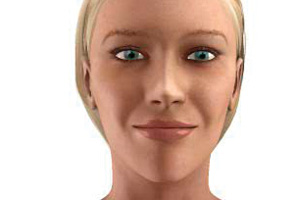Rhinoplasty
Rhinoplasty (Greek: Rhinos, "Nose" + Plassein, "to shape") is a surgical procedure which is usually performed by either an Otolaryngologist, Maxillofacial Surgeon, or Plastic Surgeon in order to improve the function (reconstructive surgery) and/or the appearance (cosmetic surgery) of a person's nose. Rhinoplasty is also commonly called a "nose reshaping" or "nose job". Rhinoplasty can be performed to meet aesthetic goals or for reconstructive purposes to correct trauma, birth defects or breathing problems. It can be combined with other surgical procedures such as chin augmentation to enhance the aesthetic results.
History of Rhinoplasty
Rhinoplasty was first developed by Sushruta, an important physician (often regarded as the "father of plastic surgery") who lived in ancient India circa 500 BC, which he first described in his text Sushruta Samhita. He and his later students and disciples used rhinoplasty to reconstruct noses that were amputated as a punishment for crimes. The techniques of forehead flap rhinoplasty he developed are practiced almost unchanged to this day. This knowledge of plastic surgery existed in India up to the late 18th century as can be seen from the reports published in Gentleman's Magazine (October 1794).
The first intranasal rhinoplasty in the West was performed by John Orlando Roe in 1887. It was later used for cosmetic purposes by Jacques Joseph (b. Jakob Lewin Joseph) in 1898 to help those who felt that the shape or size of their nose caused them embarrassment and social discomfort. His first rhinoplasty patient was a young man whose large nose caused him such embarrassment that he felt unable to appear in public. He approached Joseph because he had heard of a previous successful otoplasty, or "ear reshaping," which the surgeon had performed.
How it is Performed?
It can be performed under a general anesthetic or with local anesthetic. Incisions are made inside the nostrils (closed rhinoplasty). Sometimes, a tiny, inconspicuous incision is also made across the columella, the bit of skin that separates the nostrils (open rhinoplasty). The surgeon first separates soft tissues of the nose from the underlying structures, then reshapes the cartilage and bone. This is not a particularly painful procedure. Most people remain at home for a week. If there are external sutures, they are removed 4 to 5 days after surgery. The external cast is removed at one week. If there are internal stents, they are usually removed at one to two weeks. The periorbital bruising lasts two weeks. The swelling subsided over several months, the majority in the first one or two. Due to wound healing, there are minor and subtle shifting and settling of the nose over the first year.
In some cases, the surgeon may shape a small piece of the patient's own cartilage or bone to strengthen or change the structure of the nose. Usually the cartilage is harvested from the septum although if there isn't enough which can often occur in revision rhinoplasty, cartilage can be taken from the concha of the ear or rarely the ribs. In the rare case, again usually revision rhinoplasty, where bone is required, it is harvested from the cranium or ribs. Sometimes a synthetic implant may be used to reconstruct the nose. This is most common when agmenting the bridge of Asian noses.
To improve nasal breathing function, a septoplasty may also be performed. If there is turbinate hypertrophy, an inferior turbinectomy can be done.
There are several complications that can arise in rhinoplasty, although it is usually considered to be safe and successful. Post operative bleeding is uncommon and often resolves without needing treatment. Infection is rare and can occasionally progress to an abscess that requires surgical drainage under general anesthetic. Adhesions, which are scars that form to bridge across the nasal cavity from the septum to the turbinates, are also rare but cause nasal obstruction to breathing and usually need to be cut away. A hole can be inadvertently made at the time of surgery in the septum, called a septal perforation. This can cause chronic nose bleeding, crusting, difficult breathing and whistling with breathing.
If too much of the underlying structure of the nose (cartilage and/or bone) is removed, this can cause the overlying nasal skin to have little shape resulting in a 'polly beak' deformity. Likewise if the septum is not supported, the bridge of the nose can sink resulting in a "saddle nose" deformity. The tip of the nose can be over rotated causing the nostrils to be too visible and creating a 'miss piggy' look. If the cartilages of the tip of the nose are over resected, this can cause a pinched look to the tip. If an incision is made across the collumella (open approach rhinoplasty) there can be variable degree of numbness to the nose that may take months to resolve.
The cost of rhinoplasty varys regionally and between surgeons. If it is for functional reasons, like breathing correction, it can be covered by many health plans. For example in 2006, Ontario Canada the provincal health insurance carrier paid $480, while the cost for cosmetic rhinoplasty varied between $1000 to 10,000.




